2005 BMW Z4 2.5I child lock
[x] Cancel search: child lockPage 22 of 120
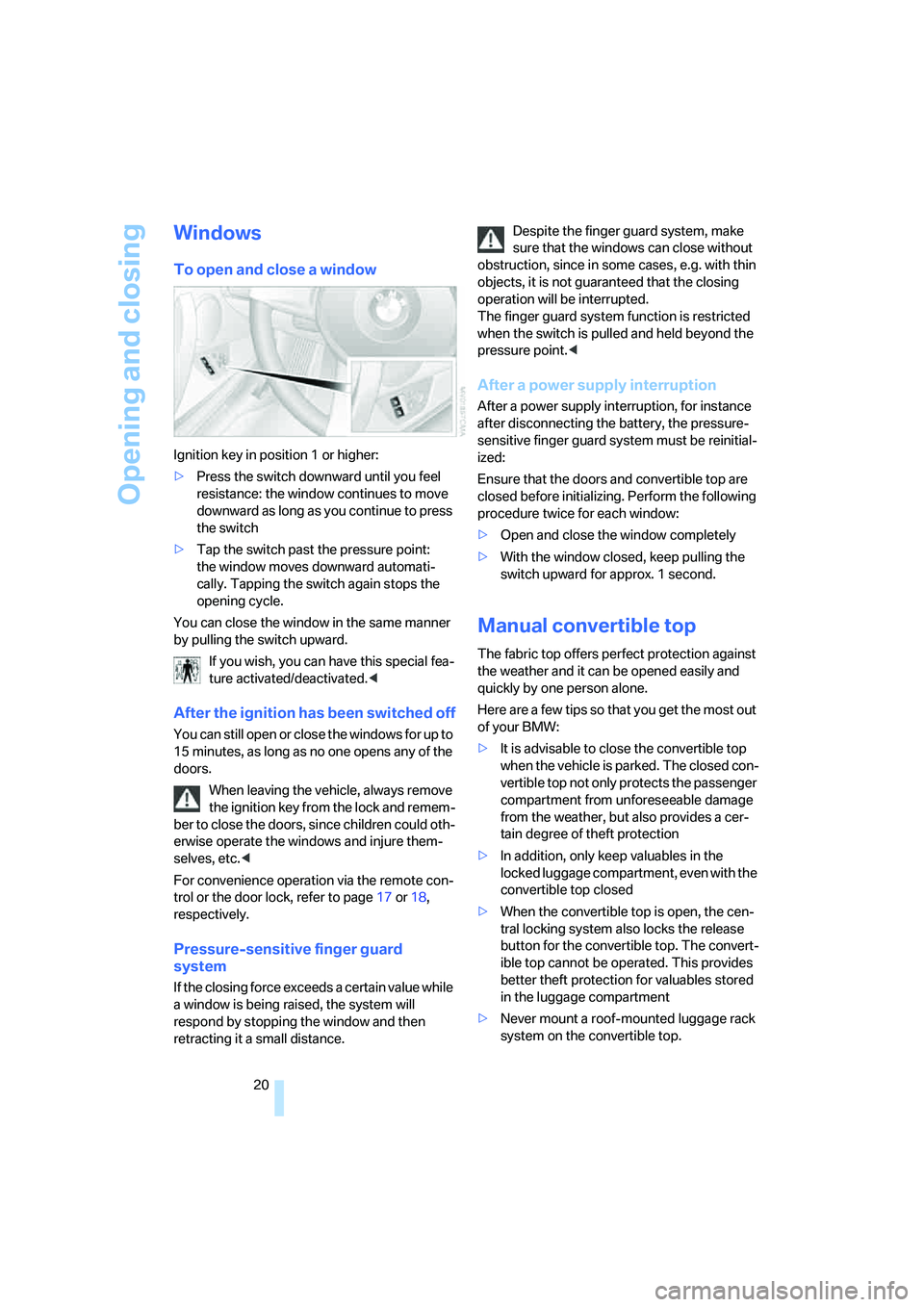
Opening and closing
20
Windows
To open and close a window
Ignition key in position 1 or higher:
>Press the switch downward until you feel
resistance: the window continues to move
downward as long as you continue to press
the switch
>Tap the switch past the pressure point:
the window moves downward automati-
cally. Tapping the switch again stops the
opening cycle.
You can close the window in the same manner
by pulling the switch upward.
If you wish, you can have this special fea-
ture activated/deactivated.<
After the ignition has been switched off
You can still open or close the windows for up to
15 minutes, as long as no one opens any of the
doors.
When leaving the vehicle, always remove
the ignition key from the lock and remem-
ber to close the doors, since children could oth-
erwise operate the windows and injure them-
selves, etc.<
For convenience operation via the remote con-
trol or the door lock, refer to page17 or18,
respectively.
Pressure-sensitive finger guard
system
If the closing force exceeds a certain value while
a window is being raised, the system will
respond by stopping the window and then
retracting it a small distance.Despite the finger guard system, make
sure that the windows can close without
obstruction, since in some cases, e.g. with thin
objects, it is not guaranteed that the closing
operation will be interrupted.
The finger guard system function is restricted
when the switch is pulled and held beyond the
pressure point.<
After a power supply interruption
After a power supply interruption, for instance
after disconnecting the battery, the pressure-
sensitive finger guard system must be reinitial-
ized:
Ensure that the doors and convertible top are
closed before initializing. Perform the following
procedure twice for each window:
>Open and close the window completely
>With the window closed, keep pulling the
switch upward for approx. 1 second.
Manual convertible top
The fabric top offers perfect protection against
the weather and it can be opened easily and
quickly by one person alone.
Here are a few tips so that you get the most out
of your BMW:
>It is advisable to close the convertible top
when the vehicle is parked. The closed con-
vertible top not only protects the passenger
compartment from unforeseeable damage
from the weather, but also provides a cer-
tain degree of theft protection
>In addition, only keep valuables in the
locked luggage compartment, even with the
convertible top closed
>When the convertible top is open, the cen-
tral locking system also locks the release
button for the convertible top. The convert-
ible top cannot be operated. This provides
better theft protection for valuables stored
in the luggage compartment
>Never mount a roof-mounted luggage rack
system on the convertible top.
Page 24 of 120
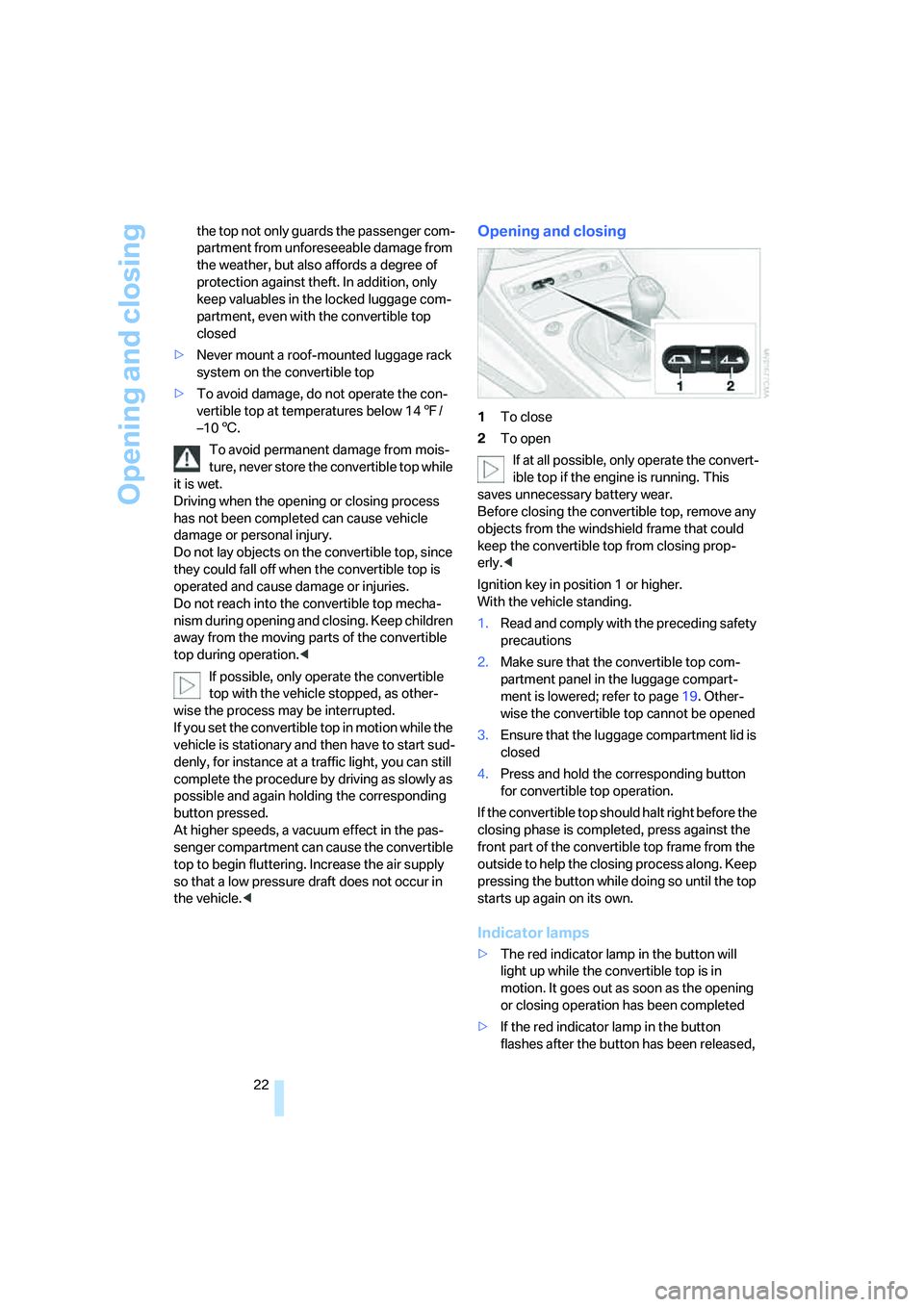
Opening and closing
22 the top not only guards the passenger com-
partment from unforeseeable damage from
the weather, but also affords a degree of
protection against theft. In addition, only
keep valuables in the locked luggage com-
partment, even with the convertible top
closed
>Never mount a roof-mounted luggage rack
system on the convertible top
>To avoid damage, do not operate the con-
vertible top at temperatures below 147/
–106.
To avoid permanent damage from mois-
ture, never store the convertible top while
it is wet.
Driving when the opening or closing process
has not been completed can cause vehicle
damage or personal injury.
Do not lay objects on the convertible top, since
they could fall off when the convertible top is
operated and cause damage or injuries.
Do not reach into the convertible top mecha-
nism during opening and closing. Keep children
away from the moving parts of the convertible
top during operation.<
If possible, only operate the convertible
top with the vehicle stopped, as other-
wise the process may be interrupted.
If you set the convertible top in motion while the
vehicle is stationary and then have to start sud-
denly, for instance at a traffic light, you can still
complete the procedure by driving as slowly as
possible and again holding the corresponding
button pressed.
At higher speeds, a vacuum effect in the pas-
senger compartment can cause the convertible
top to begin fluttering. Increase the air supply
so that a low pressure draft does not occur in
the vehicle.<
Opening and closing
1To close
2To open
If at all possible, only operate the convert-
ible top if the engine is running. This
saves unnecessary battery wear.
Before closing the convertible top, remove any
objects from the windshield frame that could
keep the convertible top from closing prop-
erly.<
Ignition key in position 1 or higher.
With the vehicle standing.
1.Read and comply with the preceding safety
precautions
2.Make sure that the convertible top com-
partment panel in the luggage compart-
ment is lowered; refer to page19. Other-
wise the convertible top cannot be opened
3.Ensure that the luggage compartment lid is
closed
4.Press and hold the corresponding button
for convertible top operation.
If the convertible top should halt right before the
closing phase is completed, press against the
front part of the convertible top frame from the
outside to help the closing process along. Keep
pressing the button while doing so until the top
starts up again on its own.
Indicator lamps
>The red indicator lamp in the button will
light up while the convertible top is in
motion. It goes out as soon as the opening
or closing operation has been completed
>If the red indicator lamp in the button
flashes after the button has been released,
Page 29 of 120
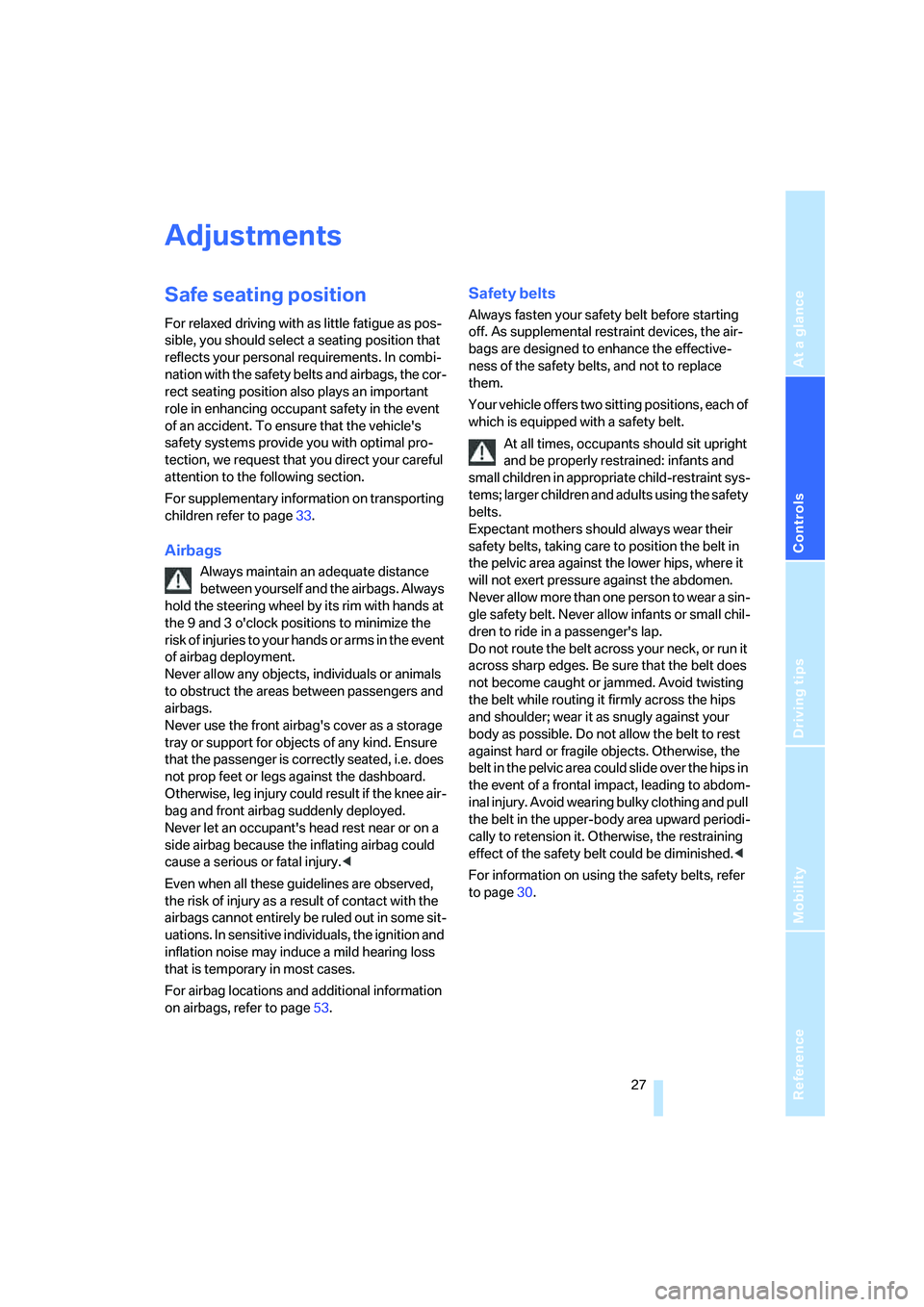
Reference
At a glance
Controls
Driving tips
Mobility
27
Adjustments
Safe seating position
For relaxed driving with as little fatigue as pos-
sible, you should select a seating position that
reflects your personal requirements. In combi-
nation with the safety belts and airbags, the cor-
rect seating position also plays an important
role in enhancing occupant safety in the event
of an accident. To ensure that the vehicle's
safety systems provide you with optimal pro-
tection, we request that you direct your careful
attention to the following section.
For supplementary information on transporting
children refer to page33.
Airbags
Always maintain an adequate distance
between yourself and the airbags. Always
hold the steering wheel by its rim with hands at
the 9 and 3 o'clock positions to minimize the
r i s k o f i n j u r i e s t o y o u r h a n d s o r a r m s i n t h e e v e n t
of airbag deployment.
Never allow any objects, individuals or animals
to obstruct the areas between passengers and
airbags.
Never use the front airbag's cover as a storage
tray or support for objects of any kind. Ensure
that the passenger is correctly seated, i.e. does
not prop feet or legs against the dashboard.
Otherwise, leg injury could result if the knee air-
bag and front airbag suddenly deployed.
Never let an occupant's head rest near or on a
side airbag because the inflating airbag could
cause a serious or fatal injury.<
Even when all these guidelines are observed,
the risk of injury as a result of contact with the
airbags cannot entirely be ruled out in some sit-
uations. In sensitive individuals, the ignition and
inflation noise may induce a mild hearing loss
that is temporary in most cases.
For airbag locations and additional information
on airbags, refer to page53.
Safety belts
Always fasten your safety belt before starting
off. As supplemental restraint devices, the air-
bags are designed to enhance the effective-
ness of the safety belts, and not to replace
them.
Your vehicle offers two sitting positions, each of
which is equipped with a safety belt.
At all times, occupants should sit upright
and be properly restrained: infants and
small children in appropriate child-restraint sys-
tems; larger children and adults using the safety
belts.
Expectant mothers should always wear their
safety belts, taking care to position the belt in
the pelvic area against the lower hips, where it
will not exert pressure against the abdomen.
N e v e r a l l o w m o r e t h a n o n e p e r s o n t o w e a r a si n -
gle safety belt. Never allow infants or small chil-
dren to ride in a passenger's lap.
Do not route the belt across your neck, or run it
across sharp edges. Be sure that the belt does
not become caught or jammed. Avoid twisting
the belt while routing it firmly across the hips
and shoulder; wear it as snugly against your
body as possible. Do not allow the belt to rest
against hard or fragile objects. Otherwise, the
belt in the pelvic area could slide over the hips in
the event of a frontal impact, leading to abdom-
inal injury. Avoid wearing bulky clothing and pull
the belt in the upper-body area upward periodi-
cally to retension it. Otherwise, the restraining
effect of the safety belt could be diminished.<
For information on using the safety belts, refer
to page30.
Page 37 of 120
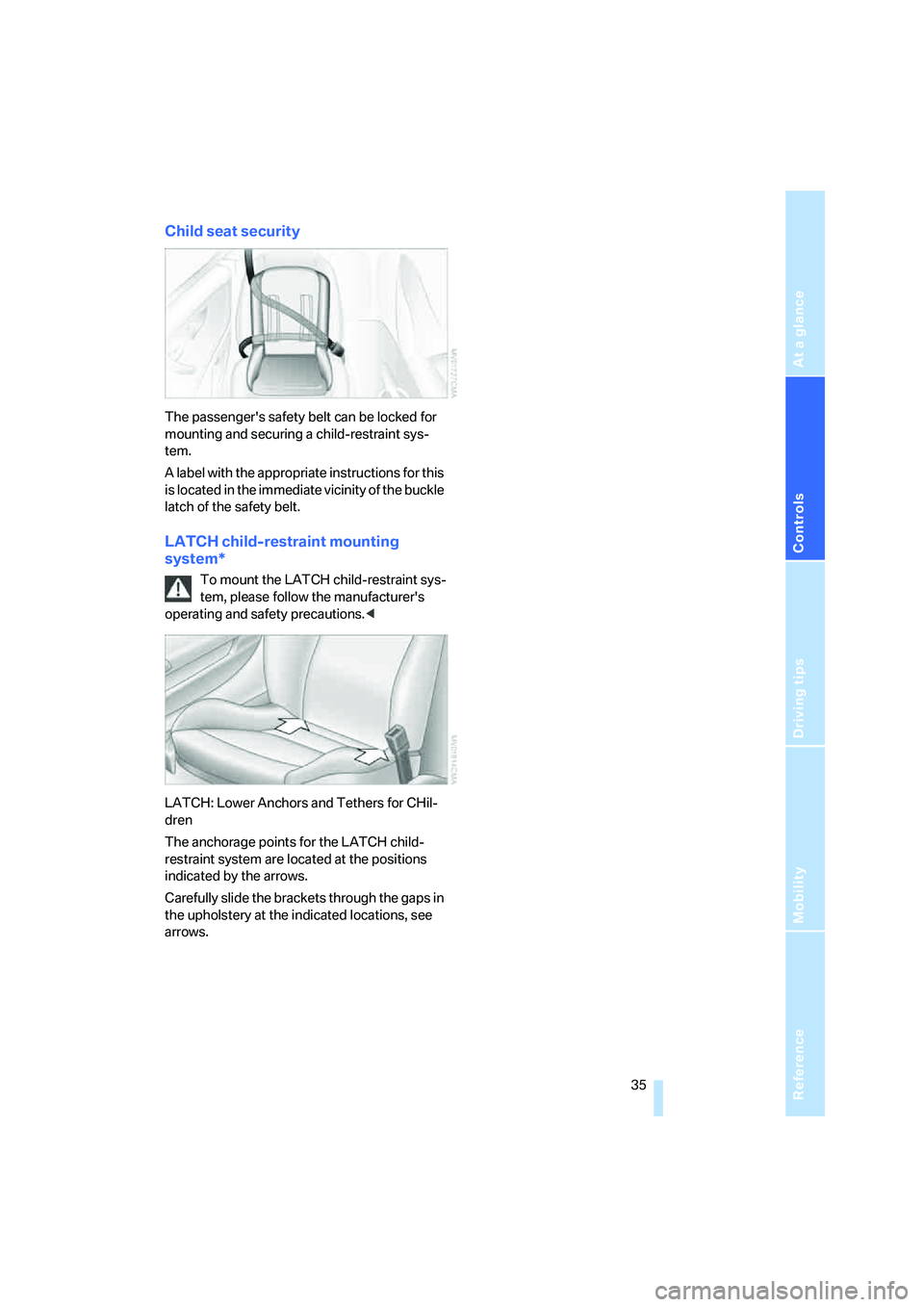
Reference
At a glance
Controls
Driving tips
Mobility
35
Child seat security
The passenger's safety belt can be locked for
mounting and securing a child-restraint sys-
tem.
A label with the appropriate instructions for this
is located in the immediate vicinity of the buckle
latch of the safety belt.
LATCH child-restraint mounting
system*
To mount the LATCH child-restraint sys-
tem, please follow the manufacturer's
operating and safety precautions.<
LATCH: Lower Anchors and Tethers for CHil-
dren
The anchorage points for the LATCH child-
restraint system are located at the positions
indicated by the arrows.
Carefully slide the brackets through the gaps in
the upholstery at the indicated locations, see
arrows.
Page 109 of 120
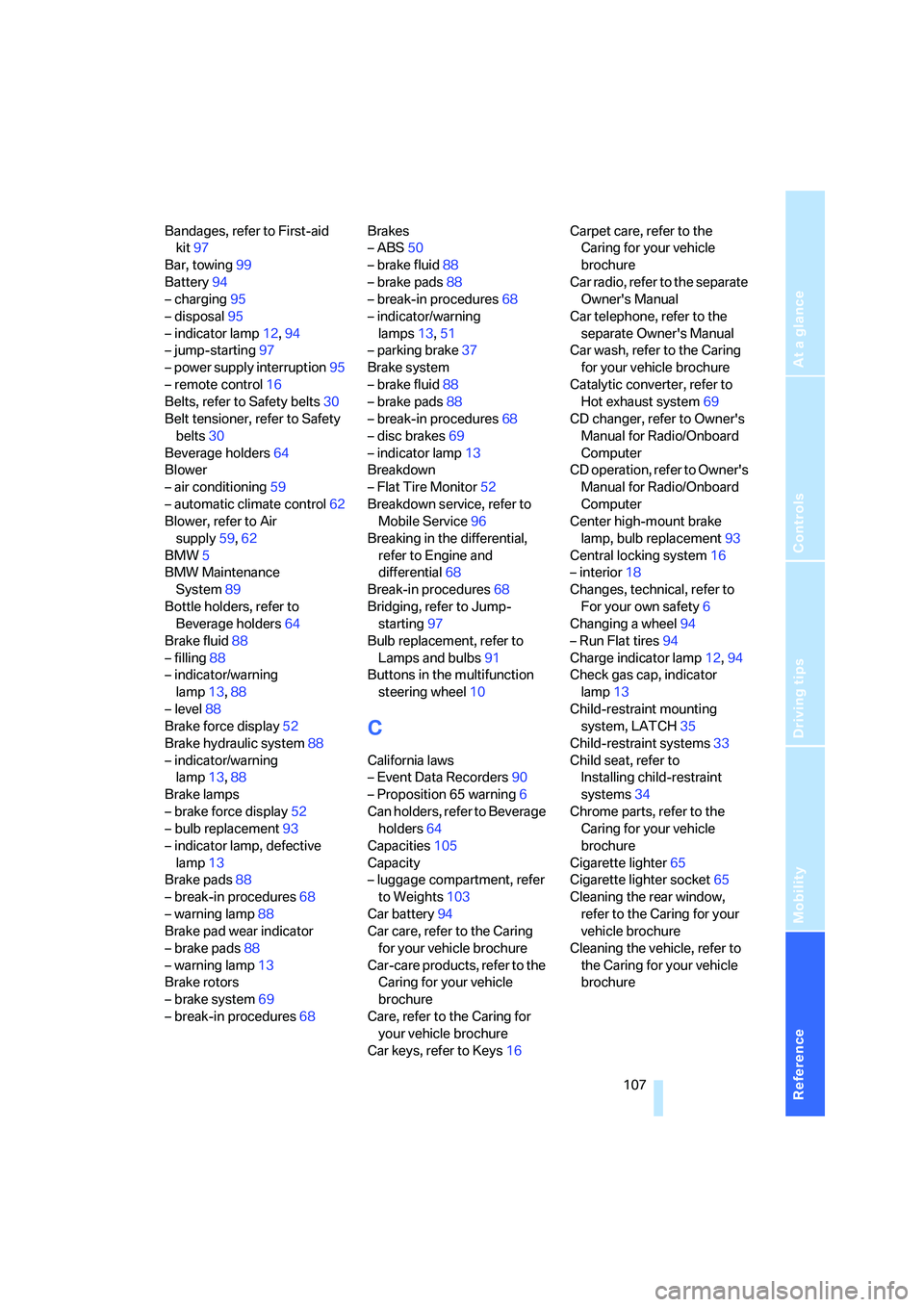
Reference
At a glance
Controls
Driving tips
Mobility
107
Bandages, refer to First-aid
kit97
Bar, towing99
Battery94
– charging95
– disposal95
– indicator lamp12,94
– jump-starting97
– power supply interruption95
– remote control16
Belts, refer to Safety belts30
Belt tensioner, refer to Safety
belts30
Beverage holders64
Blower
– air conditioning59
– automatic climate control62
Blower, refer to Air
supply59,62
BMW5
BMW Maintenance
System89
Bottle holders, refer to
Beverage holders64
Brake fluid88
– filling88
– indicator/warning
lamp13,88
– level88
Brake force display52
Brake hydraulic system88
– indicator/warning
lamp13,88
Brake lamps
– brake force display52
– bulb replacement93
– indicator lamp, defective
lamp13
Brake pads88
– break-in procedures68
– warning lamp88
Brake pad wear indicator
– brake pads88
– warning lamp13
Brake rotors
– brake system69
– break-in procedures68Brakes
– ABS50
– brake fluid88
– brake pads88
– break-in procedures68
– indicator/warning
lamps13,51
– parking brake37
Brake system
– brake fluid88
– brake pads88
– break-in procedures68
– disc brakes69
– indicator lamp13
Breakdown
– Flat Tire Monitor52
Breakdown service, refer to
Mobile Service96
Breaking in the differential,
refer to Engine and
differential68
Break-in procedures68
Bridging, refer to Jump-
starting97
Bulb replacement, refer to
Lamps and bulbs91
Buttons in the multifunction
steering wheel10
C
California laws
– Event Data Recorders90
– Proposition 65 warning6
Can holders, refer to Beverage
holders64
Capacities105
Capacity
– luggage compartment, refer
to Weights103
Car battery94
Car care, refer to the Caring
for your vehicle brochure
Car-care products, refer to the
Caring for your vehicle
brochure
Care, refer to the Caring for
your vehicle brochure
Car keys, refer to Keys16Carpet care, refer to the
Caring for your vehicle
brochure
Car radio, refer to the separate
Owner's Manual
Car telephone, refer to the
separate Owner's Manual
Car wash, refer to the Caring
for your vehicle brochure
Catalytic converter, refer to
Hot exhaust system69
CD changer, refer to Owner's
Manual for Radio/Onboard
Computer
CD operation, refer to Owner's
Manual for Radio/Onboard
Computer
Center high-mount brake
lamp, bulb replacement93
Central locking system16
– interior18
Changes, technical, refer to
For your own safety6
Changing a wheel94
– Run Flat tires94
Charge indicator lamp12,94
Check gas cap, indicator
lamp13
Child-restraint mounting
system, LATCH35
Child-restraint systems33
Child seat, refer to
Installing child-restraint
systems34
Chrome parts, refer to the
Caring for your vehicle
brochure
Cigarette lighter65
Cigarette lighter socket65
Cleaning the rear window,
refer to the Caring for your
vehicle brochure
Cleaning the vehicle, refer to
the Caring for your vehicle
brochure
Page 113 of 120

Reference
At a glance
Controls
Driving tips
Mobility
111
Indicator/warning lamp
– airbags54
– alarm system26
– automatic transmission with
Steptronic39
– brakes13
– coolant temperature47
– DSC51
– engine temperature46
– Flat Tire Monitor53
– fog lamps57
– passenger airbags34
– please fasten safety belts30
– reserve46
– sequential manual gearbox
SMG41
Indicator and warning lamps,
overview12
Individual air
distribution59,62
Individual settings, refer to
Vehicle Memory,
Key Memory31
Inflation pressure, tires78
Inflation pressure monitoring,
refer to
– Flat Tire Monitor52
Inspection47
Instrument cluster12
Instrument lighting57
Instrument panel, refer to
Cockpit10
Interior lamps57
– remote control17
Interior motion sensor26
– deactivating26
Interior rearview mirror31
– automatic dimming
feature70
Interior temperature
adjusting59,62
Interlock, refer to
Steering lock36
Intermittent
– operation, wipers43
Interval
– display, service47J
Jack94
Jacking points94
Jets, refer to
Ventilation59,63
Jump-starting97
K
Key Memory31
Keys16
Key switch for passenger
airbags33
Kickdown39
Knock control76
L
Lamps and bulbs91
LATCH, child-restraint
mounting system35
Leather care, refer to the
Caring for your vehicle
brochure
LEDs Light-emitting
diodes94
Length, refer to
Dimensions104
License plate lamps, bulb
replacement94
Light-alloy wheels, care, refer
to the Caring for your vehicle
brochure
Light-emitting diodes
LEDs94
Lighter65
Lighting
of the instruments57
Lights, refer to Parking lamps/
Low beams56
LIGHTS ON warning56
Light switch56
Load, vehicle70
Loads, refer to Cargo
loading70
Loads, securing71
Lock buttons on doors,
refer to Locking18Locking the doors
– from inside18
– from outside17
Locking the vehicle
– from inside18
– from outside16
Low beams56
– automatic56
– bulb replacement92
– indicator lamp, defective
lamp13
Lug bolts, wrench91
Luggage compartment19
– capacity103
– floor panel91
– increasing capacity19
– opening/closing,
refer to Luggage
compartment lid18
– opening from inside the
vehicle19
– opening from the outside18
– opening with remote
control17
Luggage compartment lid18
– emergency operation19
– opening from inside the
vehicle19
– opening from the outside18
– remote control17
M
M+S tires, refer to Winter
tires82
Maintenance, refer to Service
interval display47,89
Maintenance System89
Making telephone calls, refer
to Owner's Manual for
Telephone
Malfunction
– convertible top23
– door lock18
– fuel filler door76
– storage compartments64
Malfunction of electrical
accessory95
Manual convertible top20
Page 115 of 120

Reference
At a glance
Controls
Driving tips
Mobility
113
Plastic, refer to the Caring for
your vehicle brochure
Pollen, refer to
– Microfilter59
– Microfilter/activated-
charcoal filter63
Power convertible top21
Power loss
– electric power windows20
Power output, refer to Engine
data102
Power seat29
Power socket65
Power steering, electric42
Power supply interruption
– battery95
Power windows
– initializing20
Power windows protective
function, refer to Trap
protection20
Preparations for the cellular
phone65
Pressure, tires78
Pressure monitoring, tires,
refer to Flat Tire Monitor52
R
Radio, refer to the Owner's
Manual for Radio
Radio navigation, refer to the
separate Owner's Manual
Radio remote control key,
refer to Master keys with
remote control16
Rain sensor43
Reading lamps57
Rear lamps
– bulb replacement93
– indicator lamp, defective
lamp13
Rearview mirror31
Rear window defroster
– air conditioning59
– automatic climate control63
Recirculated air mode
– air conditioning59
– automatic climate control62Recirculating the air, refer to
Recirculated air
mode59,62
Reclining seat, refer to
Seats28
Refueling76
– fuel filler door76
Releasing
– hood84
Remaining distance, refer to
Range49
Remaining distance to next
service47
Remote control16
– luggage compartment lid17
– malfunction17
Replacement key16
Replacement key, refer to
New keys16
Replacement of tires82
– changing a wheel94
– new wheels and tires82
Replacing lamps, refer to
Lamps and bulbs91
Restraint systems
– for children35
– refer to Safety belts30
Reverse
– automatic transmission with
Steptronic39
– manual transmission38
Reverse gear
– sequential manual gearbox
SMG40
Rod antenna, refer to the
Caring for your vehicle
brochure
Rope, refer to Towing and
tow-starting98
RSC Runflat System
Component, refer to Run
Flat tires82
Rubber parts, refer to the
Caring for your vehicle
brochure
Runflat System Component
RSC, refer to Run Flat
tires
82Run Flat tires82
– changing a tire81,82
– changing a wheel94
– flat tire53
– tire inflation pressure78
– winter tires82
S
Safe seating position27
– with airbags27
– with safety belts27
Safety belts30
– care, refer to the Caring for
your vehicle brochure
– safe seating position27
– warning lamp12,30
Safety systems, refer to
– Airbags53
– Antilock Brake System
ABS50
– Dynamic Stability Control
DSC50
Safety tires, refer to Run Flat
tires82
Screwdriver, refer to Onboard
tool kit91
Seat adjustment28
– mechanical28
– M Sports seat29
– power29
Seat heating30
Seat memory29
Seat position, storing29
Seats28
– adjusting the sports seat29
– heating30
– memory, refer to Seat
memory29
– power adjustment29
– safe seating position27
– storing positions29
Securing, locking the vehicle
– from inside18
– from outside17
Securing loads,
refer to Cargo loading71
Page 117 of 120

Reference
At a glance
Controls
Driving tips
Mobility
115
Tire inflation pressure
– checking78
– restoring78
Tire pressure monitoring,
refer to Flat Tire Monitor52
Tires
– age80
– break-in procedures68
– changing82
– condition81
– damage81
– DOT quality grades80
– flat53
– inflation pressure78
– replacement82
– Run Flat tires82
– size78
– storage83
– temperature81
– traction80
– tread81
– tread wear80
– tread wear indicators, refer
to Tire tread, Wheel/tire
damage81
– Uniform Tire Quality
Grading80
– winter tires82
Tire storage83
Tool kit, refer to Onboard tool
kit91
Torque, refer to Engine
data102
Tow bar99
Towing98
– with sequential manual
gearbox SMG99
Towing eyelets98
Towing the vehicle98
– with automatic
transmission99
– with the front axle raised99
Tow rope99
Tow sockets for towing
eyelet98
Tow-starting98,99
Track width, refer to
Dimensions104Traction control, refer to
Dynamic Stability Control
DSC50
Transmission
– automatic transmission with
Steptronic38
– manual transmission38
– sequential manual gearbox
SMG40
Transmission detent, refer to
Range selection38
Transmission malfunction,
refer to Malfunction39
Transporting children
safely33
Transport securing device,
refer to Cargo loading71
Tread depth, refer to Tire
tread81
Tread wear indicators
in the tires, refer to
Tire tread, Wheel/tire
damage81
Trip distance recorder, refer to
Trip odometer46
Trip meter, refer to Trip
odometer46
Trip odometer46
Trunk
– refer to Luggage
compartment19
Trunk lid
– opening via remote
control17
– refer to Luggage
compartment lid18
Trunk lid, refer to Luggage
compartment lid18
Trunk volume, refer to
Luggage compartment
capacity103
Turning circle, refer to
Dimensions104
Turn signal indicators42
– indicator lamp13Turn signal indicators, bulb
replacement
– front93
– rear93
– side93
TV function, refer to Owner's
Manual for Onboard
Computer
U
Undercoating, refer to the
Caring for your vehicle
brochure
Units
– average
consumption48
– average
speed48
– temperature48
Unlocking
– from inside18
– from outside16
Used batteries, refer to
Battery disposal95
V
Vehicle
– battery94
– breaking in68
– care, refer to the Caring for
your vehicle brochure
– cargo loading70
– cleaning the rear window,
refer to the Caring for your
vehicle brochure
– engine37
– leaving the vehicle37
– measurements, refer to
Dimensions104
– parked70
– storage, refer to the Caring
for your vehicle brochure
– washing, refer to the Caring
for your vehicle brochure
– weight103
Vehicle battery94
Vehicle Memory31